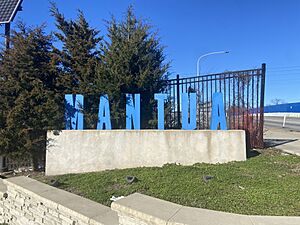Mantua, Philadelphia facts for kids
Quick facts for kids
Mantua Avenue
|
|
|---|---|

Town sign at N 34th St. and Mantua Ave.
|
|
| Country | |
| State | Pennsylvania |
| County | Philadelphia |
| City | Philadelphia |
| ZIP Code |
19104
|
| Area code(s) | 215, 267, and 445 |
Mantua is a neighborhood in the West Philadelphia part of Philadelphia, Pennsylvania. It is found north of Spring Garden Street and west of 31st Street. The northern and western parts of Mantua are mostly home to working-class African American families. The southern border, near Powelton Village, has seen some changes recently. More students from Drexel University and the University of Pennsylvania are now living there.
Contents
Mantua's History: A Community's Journey
Early Years: Changes in the 1940s and 1950s
Before the 1940s, Mantua was mainly a white neighborhood. Many people followed the Lutheran faith. However, during the 1940s, black families began to move into the area. The 1950s were a great time for Mantua. It had a wonderful shopping area on Haverford Avenue.
Facing Challenges: The 1960s
In the early 1960s, Mantua had about 19,000 residents. The neighborhood started to face challenges with street conflicts. Despite these issues, community leaders stepped up. People like Herman Wrice and Andrew Jenkins worked together. They formed important groups such as the Young Great Society and the Mantua Community Planners.
These groups organized many activities almost every day. They offered arts and crafts, singing groups, and fun day trips. They also provided tutoring sessions for students. Frank Rizzo, who was the Police Commissioner, helped these community leaders. He gave them access to local police stations. If a young person was arrested due to street-related activities, the community leaders would help. They would post bail and safely take the young person home. In return, these leaders worked with the police. They helped guide young people away from street life. Even with these efforts, Mantua faced many safety challenges during this time.
Building for the Future: The 1970s
Andrew Jenkins and the Mantua Community Planners worked with the city. Their goal was to build a recreation center in Mantua. The neighborhood's first recreation center finally opened. It is located at what is now 34th Street and Haverford Avenue. This center had playgrounds and ball courts. It also had offices, like most recreation centers. But it also had a free library! To use the play centers, you needed a library card.
Despite the safety challenges, Wrice's Young Great Society and Jenkins' Mantua Community Planners kept working. They pushed for urban renewal programs. These programs included planting trees and building new homes. Mt. Vernon Manor, a group of apartment buildings, was one of these important projects.
Leadership and New Efforts: The 1980s
Andrew Jenkins became the Deputy Mayor for eight years. In 1988, Herman Wrice started a group called Mantua Against Drugs (MAD). This group worked to improve the community.
However, there were disagreements among community leaders. This made it hard to make progress. According to Jenkins, the late 1980s were a difficult time for the neighborhood. He felt that jealousy among leaders caused problems. This stopped many good things from happening in Mantua.
Changing Times: The 1990s
During the 1990s, about 6,000 people lived in Mantua. There were also hundreds of empty lots and buildings. The movie theaters, shops, and art galleries from the 1950s were gone. They were replaced by small delis and stores selling drinks.
In the late 1990s, many empty lots and buildings were bought. They were fixed up and offered for rent. More college students started moving into Mantua. Many came from Drexel University. They were looking for affordable places to live.
Renewed Interest: The 2000s
Today, it is thought that between 500 and 1000 college students live in Mantua. This growing number of students has brought new attention to the community. Universities like Drexel University and the University of Pennsylvania are expanding nearby.
In 2002, Rick Young formed the Mantua Community Improvement Committee (MCIC). This group helps Mantua residents work with their neighbors and the City of Philadelphia. The MCIC also has programs to attract businesses and new homeowners. One such program is the Mantua Neighborhood Special Service District.
Mantua is currently undergoing revitalization. This is thanks to the MCIC's leadership. The city and universities are also providing services.
In 2005, a group called Mantua Cares was started by residents. This included the family of Herman Wrice. Mantua Cares focuses on young people's ideas for community development. They have started youth programs that teach about business. They also help students find internships and after-school jobs. Their goal is to get young people involved in their community. Their unique approach, which includes youth involvement, has been very successful. Under the leadership of E. Darnell Ryans III, Mantua Cares has won several local and city awards. These awards recognize their dedication to the community.
On September 11, 2008, Miles Mack passed away at the McAlpin Playground. This playground is at 36th and Aspen streets. Miles Mack was a respected person in the community. He created the X-Tra Miles Basketball League. He started this league himself to help young African-American males stay out of trouble. His passing was a big loss for the community. In his memory, the McAlpin Playground was renamed the Miles Mack Playground.

